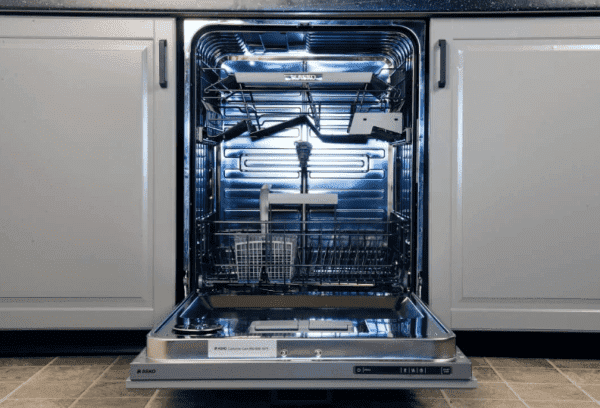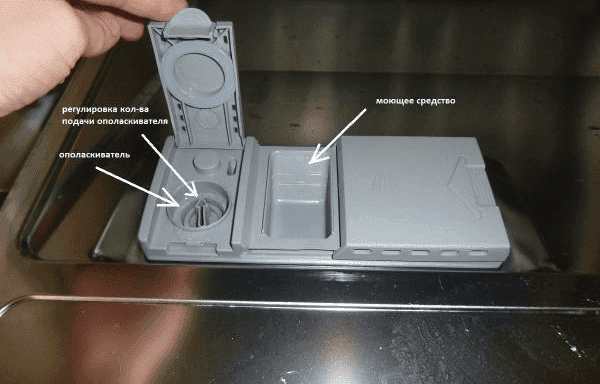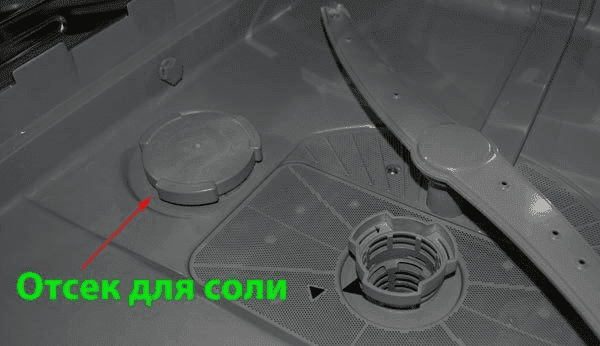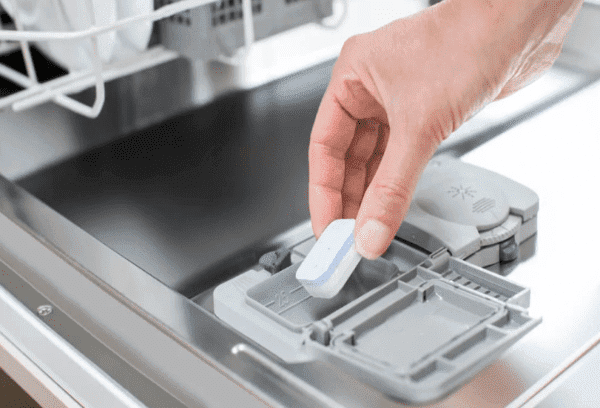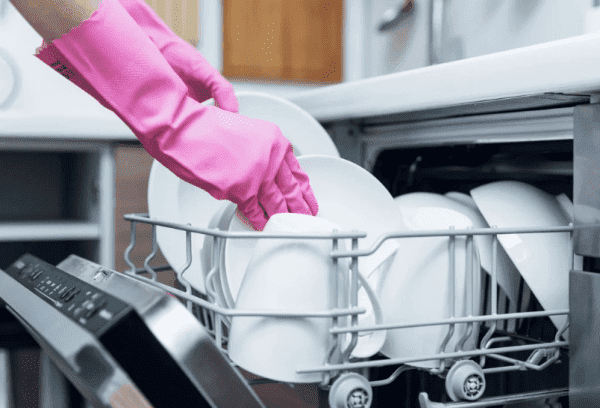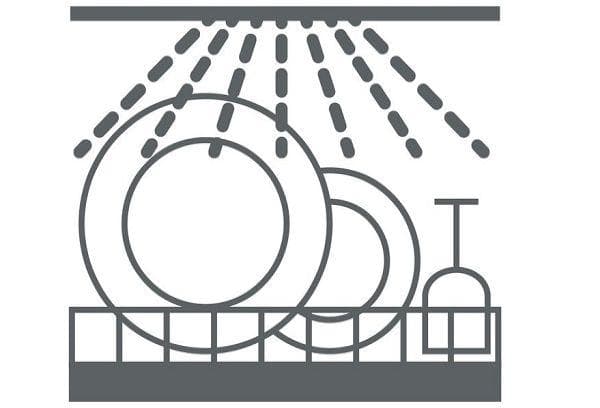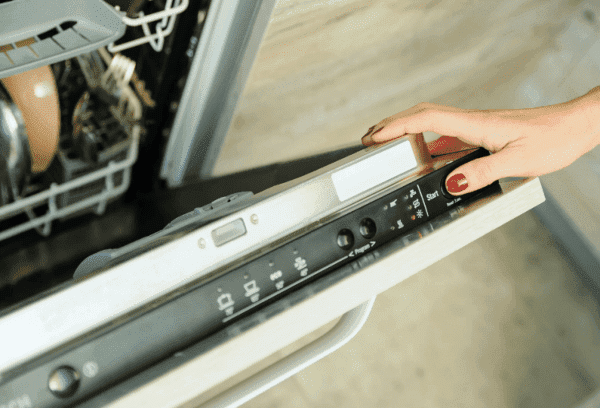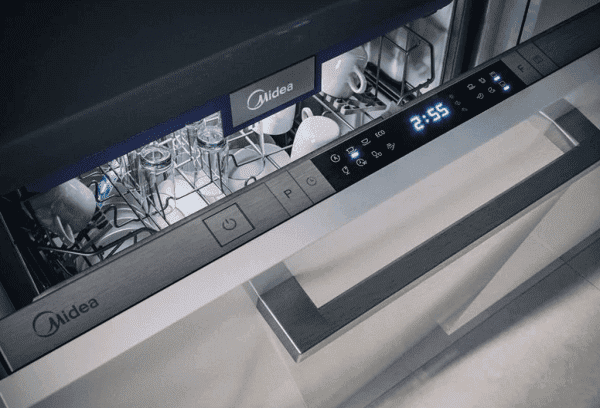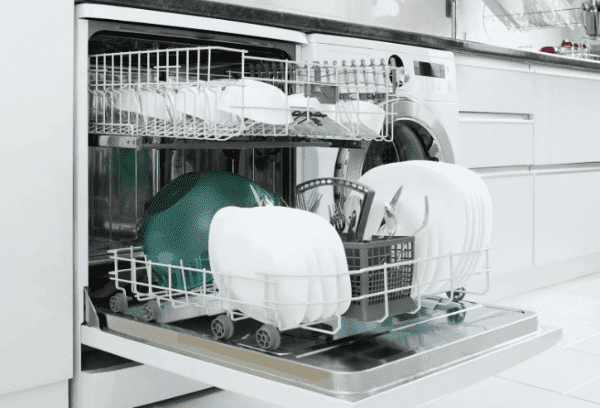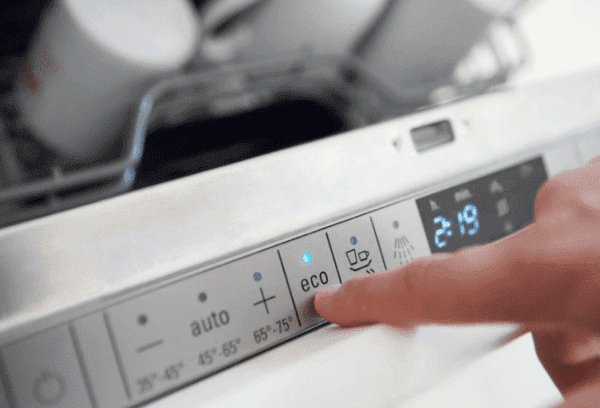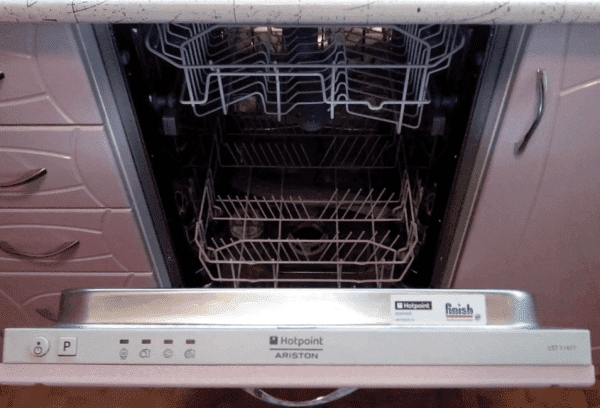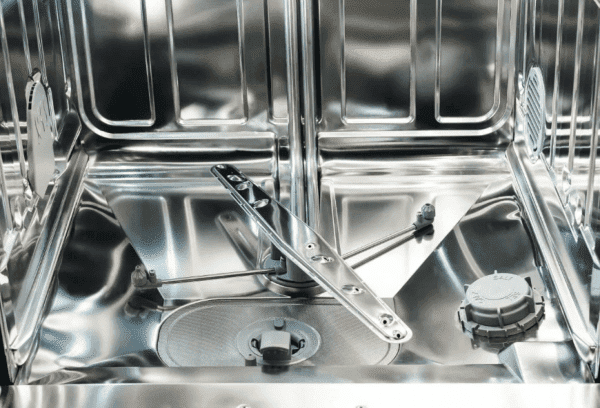A reminder for happy dishwasher owners: how to use the machine from loading to drying
Content:
Today the dishes are not washed by the person who finished dinner last. Modern technology performs the “dirty work” without any indignation. Using a dishwasher is very convenient. And the difference with hand washing is obvious - not a single housewife will wash the dishes so clean. The controls are intuitive, just like a washing machine. The devices are largely similar. A dishwasher also requires special household chemicals, and not all dishes can be “washed” in it. There are few subtleties, but they are there.

“Idle” start: how and why?
A test, or as it is also called a “dry” start, is an important stage in preparing equipment for work. There are 3 good reasons not to skip it:
- Before fully loading the dishwasher, it is important to check that it is installed correctly.
- Before work, the machine must be cleaned of industrial grease and possible contaminants.
- A test run is necessary to determine the technical condition of the machine and check the serviceability of various functions.
An “idle” start means the absence of dishes, but not detergents.
It is convenient to use the starter kit for the first time. Such kits contain small packages of products designed for several cycles. For inexperienced users, this is what you need. With the kit, you won’t have to immediately understand the medications and buy unnecessary things. It contains salt, rinse aid and detergent tablets (powder). All the chemicals are loaded into the machine.
During an “idle” start, the longest wash cycle and the highest temperature are selected.
Everyone acts as if they are using the machine for its intended purpose. Only the dishes are not loaded. The “idle” start partly helps to figure out how to use the dishwasher.
What should you pay attention to?
You must remain near the dishwasher for the entire duration of the test cycle. This way you can identify problems (if any) in time. Please note the following points:
- Normally, water flows without interruption. The machine does not stop working.
- The water should also flow out without delay.
- You should make sure that the dishwasher heats the water. The heating element cannot be checked in the store. Its malfunction can only be detected during a test run. Open the door 15-20 minutes after pressing “Start”. The machine will immediately stop working. If the heating element heats up, the chamber will be hot. Close the door to unpause the dishwasher. It will continue the cycle from where it left off.
- After the end of the cycle, there should be no moisture left in the chamber. Correctly, when drying, the water evaporates completely.
What happens inside the dishwasher during operation:
After the machine has completed the “idle” wash, you need to let it cool completely for 1-2 hours.
First start algorithm
Using your dishwasher for the first time is always exciting. Even if this is not your first dishwasher, you will need to get used to the new equipment. The algorithm of actions is as follows:
- Inspect the car. Look into the camera. There should be no foam seals, stickers or other foreign objects left in it.
- Plug it in and open the valve that shuts off the water.
- Check if the dishwasher is level. Make sure the hoses are connected and the joints are tight.
- Open the door and rotate the sprayer. It should rotate freely.
- Place salt, rinse aid and detergent in the designated compartments. Please note that salt and rinse aid are loaded for a long time, detergent - before each cycle.
- It is advisable to set the consumption of salt and rinse aid now. Salt consumption depends on water hardness and is set on the display. For the first time, select the minimum rinse aid consumption – “1” (using the regulator on the compartment). In the future, if there is a residue on the dishes, the consumption is increased. You can skip this point. The machine will operate at factory settings with average values. You can configure it later.
- Load dishes cleaned of food residues if the “idle” cycle has already taken place. If not, skip this step.
- Select the desired program using the buttons on the end (for the built-in model) or on the external panel. Click Start. Depending on the degree of soiling of the dishes, you can wash them in the “Intensive”, “Standard”, “Economy”, “Delicate” or “Fast cycle” mode.
- As soon as the cycle ends, the machine will turn off.You will hear a beep. Some models use a light beam on the floor for notification. It is red while washing dishes, and green afterwards.
How to use an Electrolux dishwasher using the example of the Ikea Skinande model:
Household chemicals
Do not use regular detergents for hand washing dishes in the dishwasher. Special household chemicals are produced for dishwashers. Conventionally, it can be divided into 4 groups:
- washing powders, gels, tablets;
- rinse aids;
- multicomponent drugs;
- regenerating salt.
Many manufacturers produce household chemicals for dishwashers. When choosing products, my eyes widen. Many people choose drugs based on price. It is not right. It happens that inexpensive products wash dishes better.
Before purchasing new household dishwashing chemicals, you need to read reviews and pay attention to the composition.
Detergent
The choice of detergent is critical. Not only the cleanliness of the dishes, but also their safety depends on its quality.
- Chlorine-containing detergents wash even very dirty dishes. Additionally, they have disinfecting and bleaching properties. But delicate dishes may suffer when used.
- Preparations with oxygen bleach and enzymes. Carefully bleach dishes and clean them from stains. Suitable for short cycles and work well at low temperatures.
- Eco-friendly cleaning products (biodegradable). They do not pollute nature and are safe for allergy sufferers. Often used in families with small children. Heavy stains are washed off worse than the two previous types.
- Multicomponent products. They contain detergent and rinse aid, and sometimes salt.Mainly available in tablet form. Easy to use for beginners. But their use is more expensive.
Experienced dishwasher users pay attention to the following point:
Dishwasher tablets cannot be dispensed. If the cycle is short, a residue may remain on the dishes.
Rinse aid
Removes detergent residue, speeds up drying and facilitates water drainage from surfaces. Rinse aid is what makes dishes look so clean. There are no drops or cloudy stains on it. Usually the drug comes in the form of a gel. Used sparingly. One bottle lasts a long time - about six months.
Advice. If you put rinse aid in the dishwasher and want to use a multi-component product, set its supply level to minimum.
Rules for laying dishes
If the dishes are placed incorrectly, dirt will not be completely washed away.
Plates and glasses may appear cloudy and dull. Don't be so quick to blame the dishwasher for this. First you need to make sure that the devices are loaded correctly. The rules for laying dishes are:
- Nothing should obstruct the rotation of the sprinklers.
- The dishes are positioned so that the liquid flows freely and falls into each recess.
- There is a separate compartment for forks, spoons and knives.
- Heavy and massive objects are laid out first: pots, pans, baking sheets (in the lower compartment).
- The top tray is exclusively for light dishes and cutlery. It also washes plastic.
Plates are placed at an angle, and deep dishes, including pots and pans, are placed upside down. All items must be stable. To do this, they are fixed with clamps and levers for fastening.A visual example of loading into an Electrolux dishwasher:
Important. You need to wash dishes in the machine after pre-cleaning. Large pieces of food will clog the drain, and then you will have to contact a specialist.
What dishes should not be washed in the dishwasher?
Almost all classic tableware can be washed in the dishwasher (stainless steel, glass, ceramic). These materials are not afraid of either high temperatures or aggressive household chemicals.
If you have doubts about a particular dishwasher, you should pay attention to the symbol that allows the use of a dishwasher.
It looks like this:
The icon may not appear on all products. You need to remember which dishes definitely cannot be washed in the dishwasher:
- containing glue;
- wooden;
- antique;
- expensive, decorated with mother-of-pearl and gilding;
- cast iron;
- aluminum;
- from noble metals - silver and gold.
Tree
First of all, a strict restriction concerns wooden utensils. Prolonged exposure to water and high temperatures lead to deformation of the wood. Chemicals are absorbed into the fibers and make the dishes unsafe for health.
If you accidentally put a wooden product in the dishwasher, you can say goodbye to it forever.
The following cannot be washed in the car:
- bamboo plates;
- wooden spatulas;
- cutting boards;
- any dishes with wooden elements (handles, holders).
Plastic
You can wash plastic food containers, various lids, bowls, and glasses in the dishwasher. The dishes are not damaged if the following conditions are met:
The plastic must be heat resistant.
Look for the icon on the bottom and evaluate the thickness of the walls. Typically, manufacturers also indicate the temperature at which dishes can be washed.Do not load the machine with thin plastic, which is easily deformed when pressed with a finger.
Advice. Secure plastic dishes with clips to prevent them from “walking” around the chamber while washing.
Remember that plastic is very light. To prevent it from deforming due to high temperature, use the top tray for loading. It is located at a sufficient distance from the heating element.
Porcelain
Both porcelain and earthenware wash well in the dishwasher. You could say they were made for each other. After washing, the plates become bright and shiny. Yellowness and plaque goes away. But there are some restrictions:
Porcelain dishes with a pattern applied without glaze should be washed with gentle products without chlorine in a delicate mode.
Crystal
There is a risk that luxury crystal items will tarnish after being washed in the dishwasher. Micro-scratches may remain on the walls from abrasive particles in the detergent. It is correct to wash crystal by hand at a temperature not exceeding 40 degrees. If your machine has a delicate mode, you can use it.
Noble and base metals
Using a dishwasher is much more convenient than washing dishes by hand. Especially one that has old ingrained plaque and hard-to-reach recesses. Don’t give in to the temptation to wash your items quickly and efficiently.
The dishwasher can wash away the niello and gold along with the dirt. Silver appliances will take on the appearance of cheap aluminum.
The ban applies to base metals:
- tin;
- lead;
- aluminum;
- copper;
- cast iron.
Cauldrons, duck pots, and frying pans made of these materials darken and lose their shine when washed in the dishwasher. The top layer of cast iron deteriorates.
You can safely wash stainless steel and nickel silver appliances if they do not have glued parts or wooden handles.
Other
A detailed list of what cannot be washed in the dishwasher can be found in the instruction book. It is especially important to remember:
- Small objects may fall through the basket bars. Properly wash them in a resealable container.
- Teflon-coated pans and molds should not be placed in the dishwasher. Aggressive chemistry and high temperature will most likely lead to the destruction of the top layer. There are exceptions. Some manufacturers allow machine washing of Teflon frying pans in a delicate mode. Examine the icons on the bottom.
- Clay pots can be washed in the dishwasher only if the clay is fired and covered with glaze.
Selecting programs to work with
Just like when washing in a washing machine, the program is of utmost importance in a dishwasher. When choosing it, they are guided by the following criteria:
- degree of contamination of dishes;
- delicacy of materials;
- amount of free time;
- expected effect.
For example, intensive washing can not only remove stubborn dirt, but also whiten white plates and disinfect dishes from all types of germs. But the cycle will last a long time. If you need to quickly wash the plates for dinner, it is better to select “Quick Wash”.
The following table will help you figure out how to use different dishwasher programs:
Please note that the consumption of water and electricity differs in different modes.
Most dishwashers have the same programs. The names may be different, but the washing parameters are not much different.
How to use a Bosch dishwasher:
Soak
Used when dishes are heavily soiled:
- when the plates were dirty for a long time;
- the food remains have dried out;
- There were large sticky marks left, dough, a layer of fat.
Pre-soaking significantly increases the efficiency of cleaning dishes.
It is worth noting that this program is not a panacea. It is better to soak dried buckwheat (a champion for marks on dishes) in the usual way in the sink.
Intensive wash
One of the longest programs. It is used primarily for washing frying pans, pots, and baking trays.
The dishwasher washes dishes at extremely high temperatures.
You need to be careful when loading the camera. Some materials may be damaged (eg plastic).
Standard mode
This program is used most often. Washing in the standard mode is suitable for different dishes. You can load plates after meals, cups, cutlery, and not too dirty pots into the basket.
The standard mode gives good results with optimal consumption of water and electricity.
Economical washing
The program is designed for washing moderately soiled dishes. During the cycle, a minimal amount of water and electricity is used. Economy mode helps to significantly save money – 20%. But not the time. The ECO wash lasts more than 3 hours.
Quick wash
Typically, a dishwasher washes dishes for a long time and thoroughly, and then dries them. A complete cleansing lasts, on average, 2 hours. Sometimes the family can't wait that long. The quick wash mode allows you to significantly speed up the process.
Dishes are washed in 30-50 minutes on average.
In this case, the drying in most models does not turn on, and the water heats up to 35-40 degrees. The program is suitable for cleaning light stains.
Delicate wash
Manufacturers of dishwashers Hotpoint Ariston, Bosch, and many others have a program designed for washing crystal, glass, and porcelain. You can wash plastic in delicate mode.The water is heated to slightly hot - 45 degrees. This is not enough to clean stubborn stains. It is better to wash very dirty dishes in the sink first.
Additional functions
Every year more and more new functions appear in dishwashers. Those who are new to technology can easily get confused. Let's clarify some points:
- Half load. Designed for washing a small amount of dishes in the top tray. During the cycle, only one sprayer works - the top one. The consumption of water, electricity and detergent is reduced by 15%, and the cycle time is reduced by 15-20 minutes.
- Self-cleaning. This function is available in all modern dishwashers (Ariston, Hansa, Electrolux). It is run once every 1-3 months to clean the machine itself. No rinse aid is added, only detergent or a special cleaner. During cleaning, the chamber must be empty, without dishes.
- Air dry. Allows you to speed up the drying of dishes and prevents them from “suffocating” when stored in the chamber. After the cycle ends, the door opens automatically. Steam escapes through a small hole and natural ventilation is provided.
The more expensive the dishwasher model, the more different functions it can perform. For example, wash dishes in “night mode” (very quietly), sterilize them with steam, and much more.
How to care for your dishwasher?
Like any other appliance, a dishwasher needs care. You need to regularly:
- Remove and clean the filter (after each cycle).
- Remove the nozzles and remove plaque in the holes (every 2-4 weeks).
- Use the self-cleaning function (every 1-3 months).
- Rinse the rinse aid container (every time before filling).
Note.Using short cycles, eco-friendly detergents and delicate programs can cause your machine to get dirty more quickly.
It is recommended to occasionally use intensive cleaning with strong chemicals. More information on how to care for your dishwasher:
Regenerating salt
Special salt must be in the dishwasher at all times. It softens water and prevents scale from appearing on parts.
The use of regenerating salt directly affects the service life of the dishwasher.
In most regions, water is hard, and the heating element quickly becomes overgrown with limescale. Then it overheats and fails. In addition, a machine without salt washes dishes worse. Detergents in hard water are ineffective. Plaques and stains may remain on the surface of the plates.
Popular brands of regenerating salt:
- Finish;
- Topper 3309;
- Topperr 3317 (improved).
Regenerating salt differs from table salt in its larger granule size and purity. It dissolves evenly and does not stick together into a lump. You cannot put regular salt in the dishwasher!
The regenerating salt compartment is located at the bottom of the dishwasher. You need to find the round cap and unscrew it. Fill the tank through a funnel, after pouring 1 liter of water inside. After this, the cycle is started.
The drug is added to the tank every 1-6 months. The frequency of manipulations depends on the hardness of the water and the regularity of use of the machine. If the compartment becomes empty, the dishwasher notifies you with an indicator. Salt is indicated by two arrows (wavy lines).
Questions and answers
How to determine and set water hardness?
The easiest way is to contact the municipal water utility in your region for information. You can call by phone. Contacts are easy to find by searching.Another convenient option is to use a special rapid test. Such tests are sold at large hardware stores. The water hardness in the dishwasher is set according to the instructions, according to the table.
Different models have their own settings. In the Bosch SPS25f machine, hold down the “A” button and press “Start”. “H:00” appears on the screen. After this, use the “C” key to set the desired value “H:00 - H:007” (“H:00” is the softest water). To save the settings, click “Start”.
What precautions should you take when using a dishwasher?
The machine cannot be connected to the network through an extension cord or adapter. It is dangerous to touch a working device with wet hands. You should not put items that are not related to dishes into the dishwasher: shoes, towels, sponges, tools, etc. Only adults can use the equipment. Children are not allowed to visit it.
Having bought a dishwasher for the first time, happy owners ask many questions about its use. And it is right. In order for equipment to do its job well and serve for a long time, you need to know everything about its operation. Standard rules are described in the instructions. Keep the book carefully.
Some points are forgotten, and the official instructions will help fill in the gaps in memory. You can find out something on the Internet or ask a neighbor (friend). There is no need to be shy about asking questions. As experience shows, even those who have been using a dishwasher for a long time sometimes come up with nuances that require clarification.
